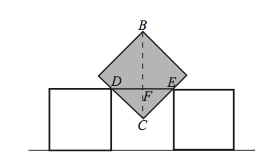2005 AMC 10A Problems/Problem 19
Revision as of 10:30, 4 July 2013 by Nathan wailes (talk | contribs)
Problem
Three one-inch squares are placed with their bases on a line. The center square is lifted out and rotated 45 degrees, as shown. Then it is centered and lowered into its original location until it touches both of the adjoining squares. How many inches is the point ![]() from the line on which the bases of the original squares were placed?
from the line on which the bases of the original squares were placed?
![[asy] unitsize(1inch); defaultpen(linewidth(.8pt)+fontsize(8pt)); draw((0,0)--((1/3) + 3*(1/2),0)); fill(((1/6) + (1/2),0)--((1/6) + (1/2),(1/2))--((1/6) + 1,(1/2))--((1/6) + 1,0)--cycle, rgb(.7,.7,.7)); draw(((1/6),0)--((1/6) + (1/2),0)--((1/6) + (1/2),(1/2))--((1/6),(1/2))--cycle); draw(((1/6) + (1/2),0)--((1/6) + (1/2),(1/2))--((1/6) + 1,(1/2))--((1/6) + 1,0)--cycle); draw(((1/6) + 1,0)--((1/6) + 1,(1/2))--((1/6) + (3/2),(1/2))--((1/6) + (3/2),0)--cycle); draw((2,0)--(2 + (1/3) + (3/2),0)); draw(((2/3) + (3/2),0)--((2/3) + 2,0)--((2/3) + 2,(1/2))--((2/3) + (3/2),(1/2))--cycle); draw(((2/3) + (5/2),0)--((2/3) + (5/2),(1/2))--((2/3) + 3,(1/2))--((2/3) + 3,0)--cycle); label("$B$",((1/6) + (1/2),(1/2)),NW); label("$B$",((2/3) + 2 + (1/4),(29/30)),NNE); draw(((1/6) + (1/2),(1/2)+0.05)..(1,.8)..((2/3) + 2 + (1/4)-.05,(29/30)),EndArrow(HookHead,3)); fill(((2/3) + 2 + (1/4),(1/4))--((2/3) + (5/2) + (1/10),(1/2) + (1/9))--((2/3) + 2 + (1/4),(29/30))--((2/3) + 2 - (1/10),(1/2) + (1/9))--cycle, rgb(.7,.7,.7)); draw(((2/3) + 2 + (1/4),(1/4))--((2/3) + (5/2) + (1/10),(1/2) + (1/9))--((2/3) + 2 + (1/4),(29/30))--((2/3) + 2 - (1/10),(1/2) + (1/9))--cycle);[/asy]](http://latex.artofproblemsolving.com/a/7/c/a7cc2885a1128684338473a8a960bdd8b0ed372f.png)
![]()
Solution
Consider the rotated middle square shown in the figure. It will drop until length ![]() is 1 inch. Then, because
is 1 inch. Then, because ![]() is a
is a ![]() triangle,
triangle, ![]() , and
, and ![]() . We know that
. We know that ![]() , so the distance from
, so the distance from ![]() to the line is
to the line is
![]()
See Also
The problems on this page are copyrighted by the Mathematical Association of America's American Mathematics Competitions. 










